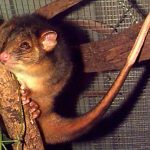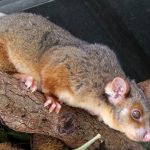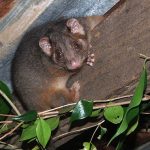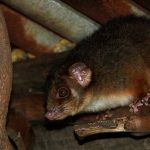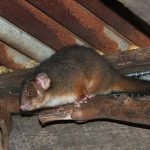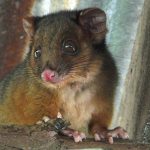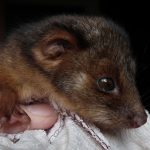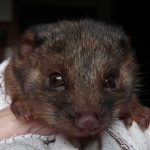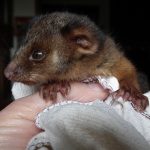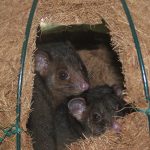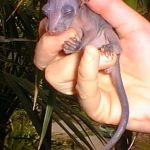RINGTAIL POSSUM
The Remarkable Ringtail Possum: A Nighttime Navigator
As dusk settles over the Australian landscape, a quiet movement stirs in the treetops. Among the shadows, the Ringtail possum emerges—a masterful climber, perfectly adapted for a life suspended above the ground. This enchanting marsupial combines agility, intelligence, and a delicate balance with its environment, making it one of the most captivating creatures in Australian wildlife.
Physical Description
| Feature | Description |
|---|---|
| Head & Body | 30–35 cm in length |
| Tail | 30–35 cm, prehensile and strong |
| Weight | 700–1100 grams |
The Ringtail possum’s most distinguishing feature is its prehensile tail, which acts as a fifth limb. When navigating narrow branches, the possum wraps its tail around twigs, providing stability and freeing its hands for climbing or gathering food. The tail is often curled when not in use and also serves as a handy tool for transporting nesting materials.
Habitat and Distribution
Ringtail possums are highly adaptable, thriving in:
- Rainforests: Where dense foliage offers shelter and abundant food.
- Eucalypt forests: Their primary source of nourishment.
- Suburban gardens: Where they take advantage of ornamental plants and fruit trees. ( what choice do they have 🙁
Their ability to live alongside humans highlights their resilience, but it also brings them into contact with new threats.
Diet and Behaviour
Nocturnal Lifestyle
Ringtail possums are strictly nocturnal, venturing out after sunset. As you walk through a quiet garden at night, you might hear the soft rustle of leaves above—evidence of their nightly foraging.
Diet
- Eucalypt leaves (main diet)
- Fresh buds and flowers
- Soft fruits
Their diet is highly specialised, relying on the nutritious young leaves and blossoms found in their habitat.
Nesting and Family Life
Nests
- Hollow logs: The preferred nesting sites, lined with leaves for comfort.
- Dreys: With fewer old trees available, possums ingeniously weave spherical nests from leaves and shredded bark, suspended in dense foliage.
Social Structure
Ringtail possums are generally peaceful, with overlapping territories. Males may defend their space, particularly during food shortages, but aggressive encounters are rare.
Reproduction
- Breeding season: March to November
- Sexual maturity: 12 months
- Litter size: Usually 2–3 young, despite the female having four teats
- Pouch life: Young spend about four months in the mother’s pouch
- Weaning: At six months
- Independence: Achieved between 8–12 months
After leaving the pouch, the young travel on their mother’s back or remain safely in the drey while she forages.
Survival Challenges
The journey to adulthood is fraught with danger:
- Predators: Dogs, cats, snakes, foxes, and powerful owls pose constant threats.
- Human impact: Road traffic and habitat loss due to land clearing reduce their chances of survival.
- Habitat decline: Fewer old trees mean fewer safe nesting sites, increasing vulnerability.
Sensory Experience
Picture a cool, damp evening in the Australian bush. The air is tinged with the crisp scent of eucalyptus. High above, you might spot a Ringtail possum silhouetted against the moonlight, its fur soft and dense, eyes shining with reflected light. Listen closely for a gentle chattering call or the whisper of leaves as it moves with surprising grace through the canopy. Its tiny, dexterous hands grip branches, and its tail curls tightly for balance—a silent, skilful acrobat at work.
Conservation Message
The Ringtail possum’s adaptability is a testament to nature’s ingenuity, yet their future is closely linked to the health of their environment. Preserving old trees, planting native vegetation, and protecting their habitats in both urban and wild settings are crucial steps in ensuring these unique marsupials continue to thrive. By learning about their lives and needs, we take the first step toward safeguarding their future.
Key Takeaways
- The Ringtail possum is a nocturnal, tree-dwelling marsupial with a remarkable prehensile tail.
- It faces threats from habitat loss, predators, and human activity.
- Their adaptability allows them to share our gardens and parks, but they need our help to survive and flourish.
Next time you step outside under the stars, look up—you may be sharing the night with one of Australia’s most endearing and resourceful creatures.

